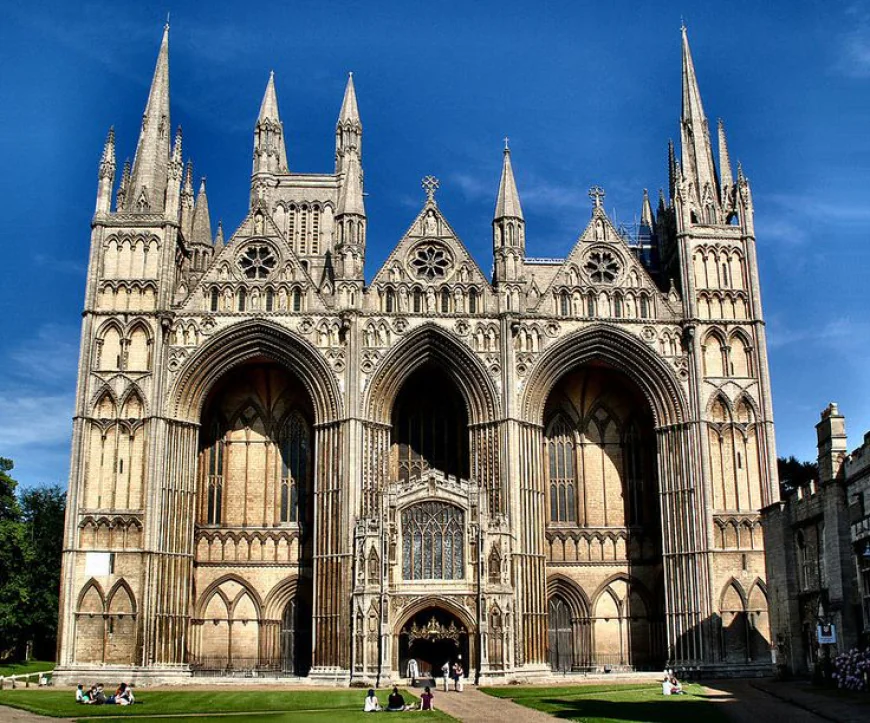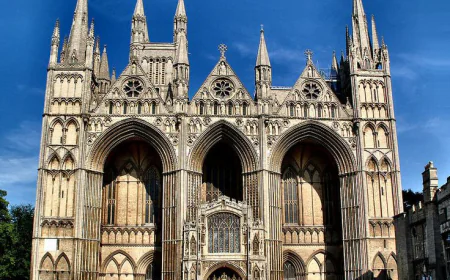Peterborough Cathedral: History & Famous Burials
Peterborough Cathedral: Diocese of Peterborough Cathedral. Discover the cathedral in Peterborough, including its famed West Front.

The Cathedral Church of St Peter, which is known as Peterborough Cathedral, is a monument of centuries of architectural development and historical value of the Diocese of Peterborough. It stands tall and proudly towers over the Peterborough landscape where numerous people around the world come and pay a visit to see its Norman underpinnings and Gothic ornaments. Its rich history is interwoven with the history of the royalty, religious leaders and the ordinary people, and this fact made the cathedral become one of the strongholds of English culture.
History and Significance
Peterborough Cathedral has a history dating back to the year 655 with the formation of a monastery and this was so initiated by King Peada of Mercia. This initial building was being demolished causing a change in architecture as follows.
The cathedral was also inspired by the fire in 1116, which also gave rise to the necessity to erect a new building, and this piece of art can be regarded as a successful example of the development of architecture through the centuries.
| Name | Details |
|---|---|
| Original Monastery | Established in 655 by King Peada of Mercia; destroyed later |
| Peterborough Abbey | Norman church that became the foundation of the modern Peterborough Cathedral |
Architectural Features
Peterborough Cathedral is known as a home of magnificent West Front which is a classic example of Norman architecture. The interior of the nave is soaring, and the wooden ceiling is the touch of medieval craftsmanish, which is rather obvious in such a segment as the south transept. The interior is lit by stained glass windows depicting biblical scenes and historical figures, and the choir stalls are still the point of attraction.
Visitor Information
Other than its architectural beauty, Peterborough Cathedral has got great historical importance as the place of burial of Catherine of Aragon, the first wife to Henry VIII. Another noteworthy aspect of the history of the cathedral at Peterborough is the death and burial of Catherine of Aragon in 1536.
The midst of the Reformation before it was moved to Westminster Abbey, Mary Queen of Scots was also buried here. Tourists have an opportunity to visit the cloister and consider the purpose of the cathedral as the place of refuge and the memorial.
Unique Aspects of Peterborough Cathedral
Peterborough Cathedral is renowned for its Norman architecture, especially its West Front. Key aspects of the cathedral and their association with the Norman style are summarized below:
| Feature | Norman Style Characteristics |
|---|---|
| West Front | Impressive example of Norman architecture. |
| Nave | Grand simplicity. |
| Construction Period | Primarily 12th century. |
Misericords: Hidden Treasures
Another exceptional attribute of Peterborough Cathedral is its series of misericords, small ledges on the under bench of the choir stalls. These enable clergy to lean a little on long services. The misericords are often decorated with elaborate carvings, as they give us an understanding of life in the Middle Ages and humor. These secret treasures provide the insight into the social and cultural background of the past of the cathedral.
Events and Community Engagement

Services and Worship
Conditionally, being the Cathedral Church of St Peter in the Diocese of Peterborough, the cathedral continues to serve as a centre of regular services and worship in the Church of England. These services serve as a continuity of the past with spiritual support and comfort to both the local people and the tourists. In the cathedral, the Bishop of Peterborough is instrumental in the religious life of the cathedral.(Learn more about Church of England on Wikipedia).
Educational Programs
Peterborough Cathedral is a very active participant of the community that is involved in various educational initiatives. These programs focus on different age groups and interests, which is a promotion of knowledge about the history of the cathedral, its architecture, and religious importance. Education programmes and events aim to inspire the future generations by different events arranged in Peterborough Cathedral.
Special Events and Festivals
Peterborough Cathedral has special events and festivals throughout the year, which attracts people and commemorates different events. These include music and drama events and history reenactments or religious festivals.
These occasions improve the cultural diversity of the area. They also help in the mission of Peterborough Cathedral to act as a community centre in the Diocese of Peterborough.
Exploring the Interior of Peterborough Cathedral

The Nave and Choir Stalls
The visitor in entering the nave of Peterborough Cathedral is at once overwhelmed by the height and majesty of the Norman architecture. This is the main area, which is a witness of the 12 th -century origins of the cathedral and, thus, evokes reflection and thought.
The eye is made to be attracted to the east end where the richly hewn choir stalls await with thrilling artistry and seating the clergy during services. History of the cathedral is carved on each stone in the nave.
Stained Glass Windows
Lighting up the interior of Peterborough Cathedral, the stained-glass windows are an excellent story-teller, and are colored in a variety fascinating to the eye. These artistic masterpieces harmonize the light that envelops the nave and creates an ethereal effect onto the artistic masterpiece and also provide a visual guide to the visitor informing about faith and the history. Its workmanship of the stained glass is equal to that on the Ely Cathedral.
The Iconic Ceiling Design
Another notable characteristic of Peterborough Cathedral is its outstanding wooden ceiling which is one of the few remaining in the medieval age. This painted ceiling gives the Norman architecture of the nave some warmth and character.
The elaborate pictures and designs give us an insight into the taste of art of the yesteryear. The wooden ceiling is the reference to the history of the cathedral.
Visiting Experience and Nearby Attractions

Guided Tours and Timings
Visitors can also engage in guided tours conducted by experienced volunteers in order to have a comprehensive view of the history and architecture of Peterborough Cathedral.
These tours provide the information about the construction of the cathedral, its main points, and the life story of such people as Catherine of Aragon and Mary Queen of Scots. When it comes to services and events, ensure that you make prior checkups on the timing. It is an experience that is incomparable to visit here.
Cathedral Grounds and Gardens
The cathedral grounds and cloister offer a peaceful retreating location after the hustle of day-to-day events. These areas provide an opportunity to have some time of quiet contemplation in the midst of well-gardened gardens.
Tourists are allowed to walk in the cloister and envision the experiences of the monks who were once staying in the monastery. The Norman architecture and the display of the Gothic architecture can be seen in the exterior of the cathedral in panoramic view.
Attractions Near Peterborough Cathedral
Besides the cathedral, there are other attractions in Peterborough to make the visit very balanced. Visit the museum and art gallery of the city to find out more about the local heritage. Take a free stroll down the river or pay a visit to local parks and gardens. Peterborough is an interesting place with its rich history and cultural products to all. The position of Catherine of Aragon.
Conclusion
The Peterborough Cathedral with its Norman underpinnings and Gothic additions is a fantastic testimony of architectural and historical development. Since the early days of Peterborough Cathedral as a monastery in 655 up to its historic pivot during the Reformation, the Cathedral has been transformed through the centuries.
The fact that Catherine of Aragon was buried there and, momentarily, Mary Queen of Scots makes it all the more important. The Cathedral Church of St Peter in Diocese of Peterborough still evokes awe and reverence and the history of the cathedral keeps changing.
FAQS
Q1: Why is Catherine of Aragon buried in Peterborough Cathedral?
Catherine of Aragon, Henry VIII’s first wife, died in 1536. Peterborough Cathedral was chosen for her dignified burial, linking the site to the Tudor dynasty.
Q2: Was Peterborough Cathedral Catholic?
Originally a Catholic monastery founded in 655, it became part of the Church of England during the Reformation and is now Anglican.
Q3: What is Peterborough Cathedral famous for?
It’s known for its Norman architecture, the burial of Catherine of Aragon, and its rich history from monastery to Anglican cathedral.
Q4: Peterborough Cathedral facts?
Founded in 655, rebuilt after a 1116 fire, it features a wooden Nave ceiling, stained glass, and is the seat of the Diocese of Peterborough.
Q5: When was Peterborough Cathedral built?
The Norman cathedral was mainly built from the 12th century after the 1116 fire, with later Gothic additions.
What's Your Reaction?
 Like
0
Like
0
 Dislike
0
Dislike
0
 Love
0
Love
0
 Funny
0
Funny
0
 Angry
0
Angry
0
 Sad
0
Sad
0
 Wow
0
Wow
0










































